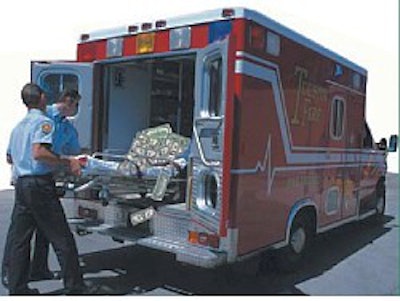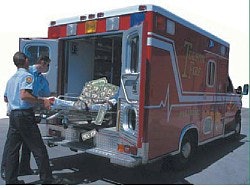

If you ask a hardwood flooring contractor about a scar on his hand, he'll probably recount a story of a table saw gone awry. Get several contractors in a room and pretty soon they're displaying scarred body parts and rehashing war stories involving nailers, saws, routers and other sharp, dangerous objects. Installing hardwood floors is a dangerous job, and no matter how many safety precautions you take, injuries are always a possibility, especially for new installers who are just learning the ropes. As an employer in the trade, you need to be concerned about not only the safety of your employees, but also the financial impact that workers' injuries can have on your business.
The average cost of a workers comp claim has more than tripled during the past 10 years, increasing at a rate 50 percent faster than the boom in overall health care costs. In many states, the problem has reached crisis proportions, with businesses laying off workers or considering closing shop altogether.
The medical bills are only the first step in the long financial march associated with an accident on the job. "Hidden costs usually come to five times the amount paid in bills," says Douglas F. Miller, president of Employers' Risk & Insurance Management in Birmingham, Ala.
In addition to the financial burden, says Miller, you lose the expertise of an experienced employee. You must assign a less-skilled individual to perform the work, and that may involve overtime. There are also the administrative costs of filing paperwork and keeping up with the claim. Then there is the time required for following up with the employee and seeing how he is doing.
How can you cut your workers comp costs? Twelve consultants from around the country offer the following techniques:
Work With Your Employees
1. Institute a safety program. "Safety programs and loss prevention are the most important techniques for controlling costs," says Daniel C. Free, president of Insurance Audit & Inspection in Indianapolis, Ind. There's no better way to lower workers comp claims than to prevent accidents from happening.
Establish a safety committee to identify and correct hazards and activities that can lead to injury. Investigate your operations in a methodical way and determine what hazards could cause accidents.
Include personnel from all levels. "Bring the workers in to identify hazards," says Donald Marano, president of Industrial Health Inc. in Salt Lake City, Utah. "They know more about problems than management." Structure a hazard self-inspection done both periodically and on a surprise basis. Detect and abate those hazards before they cause loss.
Free suggests getting a history report of claims from your insurance carrier and identifying the type of accidents that are most common. "See what's causing your losses and then make the workplace safer," he says.
It's not enough to post signs about safety. Their effect wears off rapidly. In contrast, studies show that workplace accidents are reduced by any activity that reminds workers of the need for safety, such as a periodic lecture on the right way to lift heavy equipment or use a tablesaw.
2. Use incentives. Incentives reward employees when workplace accidents are few. They can be as simple as having a company-sponsored party every time the business goes a certain number of days without an accident. Other employers design point systems that award bonuses for a string of safe days.
"The best pre-accident behavior you can elicit is the reduction of hazards," says Albert A. Mangone, director of customer training and loss prevention for the service retail industry at Liberty Mutual Insurance Group in Boston. "If you can put your employees in competition with each other for the reduction of hazards, that would be a tremendous way to reduce loss."
"The whole idea is to get the safety awareness level up," says Seth Marshall, president of Safety Pays, a Santa Monica, Calif.-based company that licenses use of an incentive program. "A company's workers comp dilemma begins and ends with its employees. So the solution must come from the inside." Marshall's program employs a bingo card technique for encouraging employees to work safely.
Incentives work because they raise the workers' safety awareness. They focus the attention on overcoming the problem. But they must be changed from time to time. "Don't be repetitious," warns Michael Nicholas, president of California Loss Control in San Dimas, Calif. "Change the program around. Maybe instead of cash awards you give away baseball tickets. But find out what the employees want by asking them."
3. Explain the problem to employees. Tell your employees how workers comp premiums are impacting the financial strength of your business. Get them on your side. They need to realize what hurts the employer hurts the worker and can even endanger continued employment. Knowledgeable employees are more likely to support safety programs.
"Make the relationship as cordial as possible, so that when the employee is hurt he feels he is supported by his employer," says Ruth Gastel, director of issues analysis at the New York-based Insurance Information Institute. Employees who feel good about their employer are more apt to comply with recommendations regarding early return to work.
Employees should be informed about the no-fault nature of the state workers comp laws. "Workers who know their rights are less likely to hire attorneys to represent them, which drives up costs for employers," says Gastel.
4. Respond quickly to accidents. Make sure the injured worker gets the proper medical attention quickly. "Employees who see that management is concerned about their safety feel better about their company," says Free. "People want to feel as though they are part of the company, not that the employer is just using them to make money and doesn't care if they get hurt."
Call the worker at home to express your concern about his well-being. "Get a dialogue going," says Free. "Ask the employee how the accident happened and what the business can do to keep it from happening again."
Make sure the worker understands that you do not resent the accident. Such feelings from an employer can lengthen recovery times and drive up workers comp costs.
5. Plan transitional work positions. This effective technique is used by too few employers. Before an accident happens, plan for transitional work positions. These are jobs injured workers can do so that they are not just sitting at home recuperating.
"The number one way to save workers comp money is to reduce time loss," says Norman Peterson, president of his own consulting firm in Ashland, Ore. "Sixty to 65 percent of all injury costs represent indemnity to employees for work time loss, not medical bills. Everyone concentrates on the medical, but few concentrate on the indemnity."
"Preplanning early return to work will save from 20 to 30 times what other strategies will save," says Peterson. "Why? Because it deals with the key problem: eliminating time loss."
Getting the worker off the workers comp roll by using transitional work positions saves perhaps fully half of that 60 percent of injury costs represented by time loss, says Peterson. Perhaps your worker can't run the big machine yet, but he can cut custom parquets or tune up machines. Reducing the time that a worker is off work cuts back on your premium increases. It reduces the involvement of other players, such as attorneys and clinics, in the workers comp system. And studies show that people who work recover faster than those who don't.
Once you have outlined a number of transitional jobs, communicate what you have done for the employees. "Employees should know before they get injured that they will have a job and what they will be doing," says Robert J. Will, a workers comp consultant in Long Lake, Minn. "Write down descriptions of the transitional jobs and give a copy to each employee. Also mention your policy during initial interviews with job applicants. Employees need to know that if they get hurt at your company they will be back working—not off at the golf course."
Work With Your Broker
The following techniques relate to how you interact with your insurance broker and carrier. Consult with your state insurance department or attorney prior to employing any of them. What's legal in one state is flat-out illegal in another.
Your first step is to make sure you understand how your premiums are calculated. "Before you can put together a program to cut workers comp costs, you have to understand the modification experience rating calculation, which is used to calculate your premium," says Bonnie Brook, president of Stephenson and Brook, a loss control firm in Marblehead, Mass. "Then you can install a system to manage all of the components."
6. Pay premiums only on straight time. A common clerical error is to include overtime in the financial data reported to the insurance carrier. "In most states, you are only required to pay premiums on straight time," advises Edward M. Welch, who teaches labor and industrial relations at Michigan State University. "If employers don't separate out overtime, they end up paying higher premiums."
To solve the problem, make sure your accountants are familiar with your state's workers comp law. They should provide you with a breakdown of labor expense categories. Check the numbers against the reporting form that goes to your carrier.
7. Reclassify your employees. In most states, premiums depend on the classification of your employees. Clerical staffers are in a relatively cheap classification. Vehicle drivers are in a more expensive one. If your employees are classified incorrectly, you may be paying too much in premiums.
"Insist that your insurance agent gives you a full copy of the class code book that has the entire description for each code class and the class code numbers, and the corresponding rate for each class," says Robert J. Will. "See if you can find codes that relate more closely to what your employees do."
8. Pay small claims yourself. If it's legal in your state, you should consider paying small claims yourself. Typically, an employer pays the first $250 or $500 toward the medical for each accident. The idea is to save on your premium, in the same way that a deductible reduces your fire insurance premium.
"There is money to be saved in taking a deductible," says Will. "Also, if the employer tells workers that the business is paying a deductible, the worker is less likely to file a bogus claim because they know their employer will have to pay for it, not some billion-dollar insurance company."
However, this is a tricky area legally. "You need to be careful to make sure your payments are officially sanctioned by state law," cautions Tom Iverson, branch manager for the Portland, Ore. office of Employers Benefit Insurance, which writes workers comp insurance in over a dozen states.
Keep in mind, however, that in many states if you pay a deductible you will no longer be able to contest, whether the accident was work related, even if you discover evidence to the contrary. The result can be a big increase in your premiums for an accident that occurred outside the workplace.
In most states, the insurance company pays the deductible amount to the medical facility, and you reimburse the insurance company. Don't try to keep your premiums from going up by failing to file papers that report the accident to your carrier. "If you fail to report an accident to your insurance carrier, you may be subject to severe fines and penalties," says Iverson.
Moreover, what looks like a small medical problem at first may become worse. "Every carrier in the country can show files that started out as a small medical bill and ended up as total disability," cautions Iverson. If a small medical problem mushrooms into a big one, your attempt to hide the accident in the beginning will be discovered, and the insurance carrier may contest paying the bill.
9. Find and correct clerical errors. You should review all of the paperwork relating to your insurance to locate errors that can be inflating your premiums.
"There is a high risk of clerical errors," says Brook. "Audited payroll information can get transposed incorrectly. A line might read $1 million instead of $100,000."
Employers should not abdicate the responsibility for case management to insurance companies because "insurance companies do not have the financial incentive, in the way the premiums are calculated, to manage the cases quickly and assertively," says Brook. "They become very reactive, concentrating on administering the cases very well. But they do not take a proactive stand in terms of strategizing individual cases."
Have an outside medical expert review all of your medical bills for errors and appropriateness of expenses. Review how cases are handled from beginning to end. Were cases referred to appropriate medical facilities early enough? Were payments made on a timely basis to avoid fines?
10. Shop for the best insurance carrier. "We've had competitive pricing in Michigan for 10 years now, but we still find that some companies don't shop around," says Welch of the University of Michigan. "The premium spread can vary as much as 25 to 50 percent."
Those numbers speak for themselves. But remember to shop for factors other than premium. "The cheapest is not always the best," says Peterson. He suggests you consider the quality of the work that the carrier does. A carrier may offer cheaper premiums because there are fewer claims examiners on staff. "How many files are there for each claims examiner?" Peterson asks. "If there are too many, he is likely to miss something."
Suppose such a firm takes three months to follow up on a medical report not received. Says Peterson: "During that time the worker may get $2,000 a month in time loss, so you end up spending $6,000 more."
Make sure the insurance carrier's loss control division, which provides assistance to clients who want to reduce workplace accidents, is proactive. Some carriers provide plenty of advice; others simply go through the motions of what is mandated by state regulations.
11. Self-insure, or form an association with other employers. "It's legal for employers to self-insure in 47 states," says Eric Gamble, a research analyst at the U.S. Chamber of Commerce. "You have to give proof to the state that you have the funds to do it successfully. And in 28 states it is legal for smaller companies to pool their resources into associations to self-insure as a group."
How do you know when you are big enough to self-insure? There are many variables, and you need to consult a specialist in the area. But if a business is paying over $500,000 in annual premiums, it is almost always in its interest to self-insure. Depending on the state and many other variables, self-insurance may also be a viable alternative if the business is paying as little as $100,000. If premiums are less than that, self-insurance is seldom viable.
As for group insurance, this often begins to be viable when an individual business is paying $7,500 in annual premiums. Again, this can vary by state.
12. Join drug testing programs. "In Florida and some other states, you get a 20 percent reduction in your premium if you join a drug testing program," says Gamble of the U.S. Chamber of Commerce. "I think this will spread to additional states because a fair proportion of accidents are caused by drug related activities." Work this out with your insurance carrier.
Most of the consultants emphasize a key point: The most effective way to reduce workers comp costs is to encourage your employees to make safety a primary concern. Let them know that you are concerned about their safety and about containing workers comp costs.
"You have to care for your employees," says Douglas F. Miller. "If you take care of your people, they will take care of you."
Cut Comp Costs
1. Start a safety program.2. Use incentives.3. Explain the problem to employees.4. Respond quickly to accidents.5. Plan transitional work slots.6. Pay premiums on straight time.7. Reclassify your employees.8. Pay small claims yourself.9. Correct clerical errors.10. Shop for a carrier.11. Self-insure or join an association.12. Join a drug program.
Note: The legality of some steps will vary by state.

































